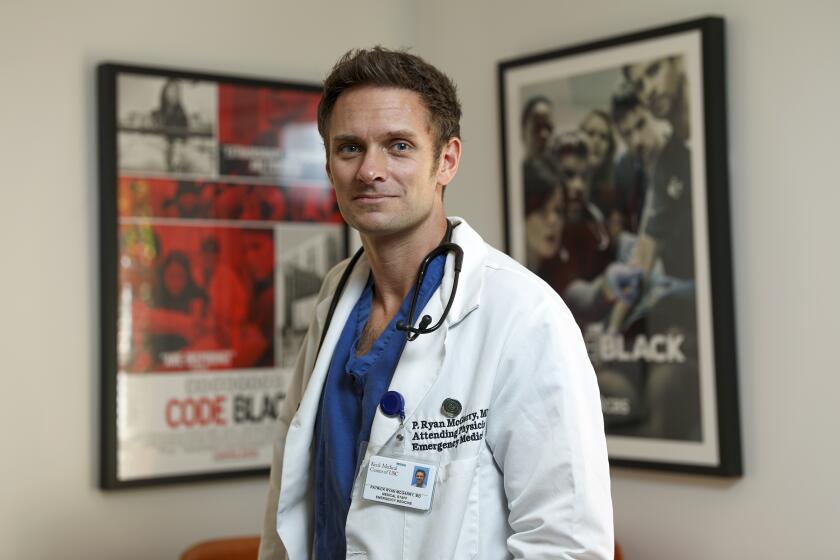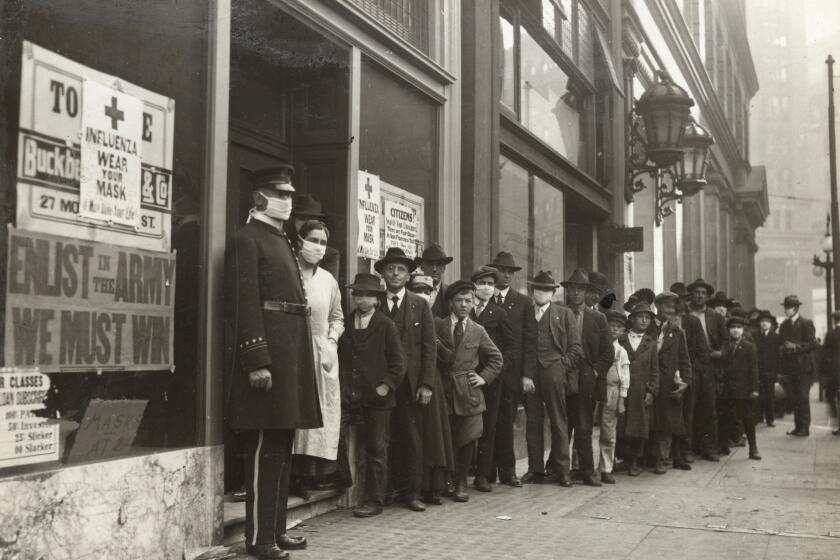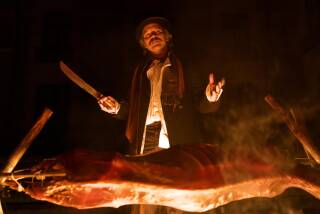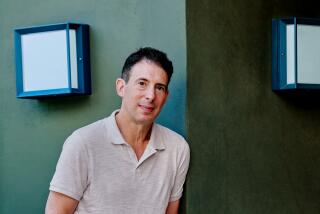Bingeing on doom: Expert on world’s 14th century pandemic attracts a cult following
- Share via
Before COVID-19, Purdue University English professor Dorsey Armstrong was well known in a way that only other enthusiasts of medieval literature and culture might appreciate.
That is to say, she once got a discount on a replica of an Anglo-Saxon drinking horn — made from an actual cattle horn — because a guy at a conference recognized her.
“That’s the only time I felt famous,” said Armstrong, an expert in medieval studies who heads the English department at Purdue in Indiana. “I got a really cool drinking horn. And whenever I teach ‘Beowulf,’ I bring it out and I pass it around.”
But since the start of the pandemic, Armstrong, 49, has gained a whole new level of acclaim for her old-world expertise. She’s the lecturer on “The Black Death: The World’s Most Devastating Plague,” a video series that became must-see TV this spring when it streamed on Amazon Prime, just as stuck-at-home 21st-century humans were reeling from the novel coronavirus crisis.
In 24 surprisingly compelling episodes, Armstrong introduced the devastation of the mid-14th century to doom-obsessed modern viewers. The flea-driven plague, also known as the “Great Mortality,” overran Eurasia and North Africa from 1347 to 1353, killing tens of millions of people and wiping out half of Europe’s population.
The series was filmed before the COVID-19 pandemic, in 2016, as part of the Great Courses, a compendium of college-level audio and video lectures. But “The Black Death” has spurred a broad cult following for Armstrong — even as it underscores the dismaying parallels between the great plague and the deadly disease now circling the globe.
“I just wish that the course were not quite so relevant at the moment,” said Armstrong, whose parents and siblings are among those who have contracted COVID-19 and recovered.
Since March, she has received a stream of daily emails from people who binge-watched “The Black Death,” all wanting to know whether things are as bad now as they were back then.
The answer, thankfully, is no, Armstrong said. Though COVID-19 has infected more than 14.5 million people and killed at least 600,000 worldwide, the proportion of deaths doesn’t compare with the devastation caused by the “Great Mortality.”
Dr. Ryan McGarry helped direct the Netflix documentary ‘Pandemic: How to Prevent an Outbreak.’ The USC doctor expects to be treating patients soon for the coronavirus. ‘It’s going to change our lives forever,’ he said.
The ferocious pandemic was dubbed the bubonic plague, reflecting the painful and (at the time) mysterious swellings, known as buboes, that developed in the lymph nodes of the neck, armpits and groin of those infected. The swellings oozed blood and pus, even as the unfortunate patients suffered other terrible symptoms: fever, chills, body aches, vomiting and diarrhea — often followed quickly by death.
As Armstrong notes, the disease could take other grisly forms: pneumonic plague, which infects the lungs, and septicemic plague, where the infection spreads to the blood, often causing skin on the fingers, toes and nose to blacken and die.
The Black Death originated in China and spread along trade routes, turning the Silk Road into a superhighway of infection. It arrived in many places via trading ships, the disease long believed to be carried by the fleas on rats that coexisted closely with humans. A more recent theory contends that fleas and lice on humans themselves helped spread the disease widely. As deaths mounted, populations in region after region struggled vainly to understand its cause or cure.
“The good news is that, all things considered, we are in a much better position than those poor people who had to survive the Black Death,” Armstrong said. “The mortality rate for the Black Death, for those who contracted it, was something like 80%. And we’re still in single digits.”
The modern world also has the advantage of seven centuries of scientific discovery that can root the current pandemic in a rogue coronavirus and target a treatment — and ultimately a cure — based on that understanding.
By contrast, humans suffering through the Black Death blamed an unfavorable conjunction of planets, “bad air,” earthquakes and God’s wrath. It wasn’t until 1894 that Swiss scientist Alexandre Yersin discovered the bacillus that caused the plague: Yersinia pestis, named in his honor.
“During the Black Death, what was really terrifying about that is they really had no idea at all what it was,” Armstrong said. “They had no good science to help them figure out how to cope with it.”
Still, there are some unsettling similarities between societal responses to the plague and COVID-19. In both cases, some officials tried to downplay the severity of the outbreak and the far-reaching economic and social effects. In Florence, Italy, for instance, members of the elite ruling class, decimated by the plague, faced a rebellion from the newly powerful working class, Armstrong said.
Many people, from ordinary peasants to local religious leaders, took the plague seriously and tried to carry out their normal duties. Clergy members were called to the homes of the ill to provide last rites, often contracting the disease in the process. Others, however, ignored the calamity, turning to hedonism and debauchery, “figuring that if they were going to die, they might as well enjoy themselves,” Armstrong said.
“What I would say is that people are the same then as now,” she observed. “Humans, when they’re together in a large group, often do dumb things. And it’s frustrating that so many people don’t seem to be learning lessons from the past.”
It has been “particularly horrifying,” Armstrong said, to see Asian Americans targeted as the presumed cause of the COVID-19 crisis. During the plague, Jews were scapegoated — and killed — as the possible source of the scourge.
“To think that anyone thinks you can call it ‘kung flu,’ which is so racist,” Armstrong said, referring to President Trump’s characterization of COVID-19. “It’s really distressing. We have international travel. Wherever it originated, it would have spread around the globe.”
Amazon Prime officials wouldn’t say how many people have viewed the series since March. But Cale Pritchett, vice president of marketing for the Great Courses, said tens of thousands of viewers have watched the show each month for the last four years. “It has been a constant in our top 10,” he said. “For a while, it was No. 1.”
Armstrong’s clear mastery of the subject — her doctorate is in medieval literature — and her easygoing teaching style make for engaging TV. The show is set in an office decorated with replicas of skulls, bones and a distinctive beaked doctor’s mask that was filled with sweet-smelling flowers to ward off the plague. Prop rats migrate around the set.
Armstrong, who favors brightly colored blazers, stands to talk through the 12 hours of lectures, striding back and forth across an ornate woven rug. She leavens the often-grisly subject matter with dark humor, reminding viewers, for instance, that the bodies of plague victims have been described as being layered in mass graves the way cheese is layered in lasagna.
In the more than 300 reviews of the series online, viewers note her approachable style. “She doesn’t come across as an intellectual snob,” wrote one. “I wish I would have had her as a professor when I was in college.”
California lessons from the 1918 pandemic: San Francisco dithered; Los Angeles acted and saved lives
San Francisco went mask crazy. Los Angeles shut down early and stayed closed longer, but not long enough. Some lessons from the 1918 Spanish flu.
Because of her familiarity with the plague, Armstrong was alarmed this year when early reports emerged of an unknown virus spreading through China.
“I’m always worried about pandemic,” said Armstrong, the mother of 13-year-old twin girls. “I have peanut butter and toilet paper and water in a cabinet in the basement, even when there is no threat of a pandemic, because that is the situation that is the scariest. Especially if it’s a novel virus, which is what this is.”
In recent months, Armstrong’s fears were realized as four family members — her parents in Seattle, her brother in New York and her sister in the Bay area — contracted COVID-19. They’ve all since recovered, though her mother was hospitalized and received the antiviral drug remdesivir to aid her healing.
If there’s one strong parallel between the Black Death and the current pandemic, it’s the social upheaval spurred by both, Armstrong said. The 14th-century plague upended the rigid social structure of the era, which had confined people to narrow roles of clergy, nobility and peasant.
“Humanity came back after that,” said Armstrong. “And some people would argue that it was that external pressure that changed society so radically that gave us eventually things like the Renaissance and the Protestant Reformation that all have their roots in that major event.”
Perhaps current protests and calls for political, economic and social change may have lasting impact too.
“My hope is that we get something good out of this,” Armstrong said.
KHN (Kaiser Health News) is a nonprofit news service covering health issues. It is an editorially independent program of KFF (Kaiser Family Foundation) that is not affiliated with Kaiser Permanente.
More to Read
The biggest entertainment stories
Get our big stories about Hollywood, film, television, music, arts, culture and more right in your inbox as soon as they publish.
You may occasionally receive promotional content from the Los Angeles Times.












